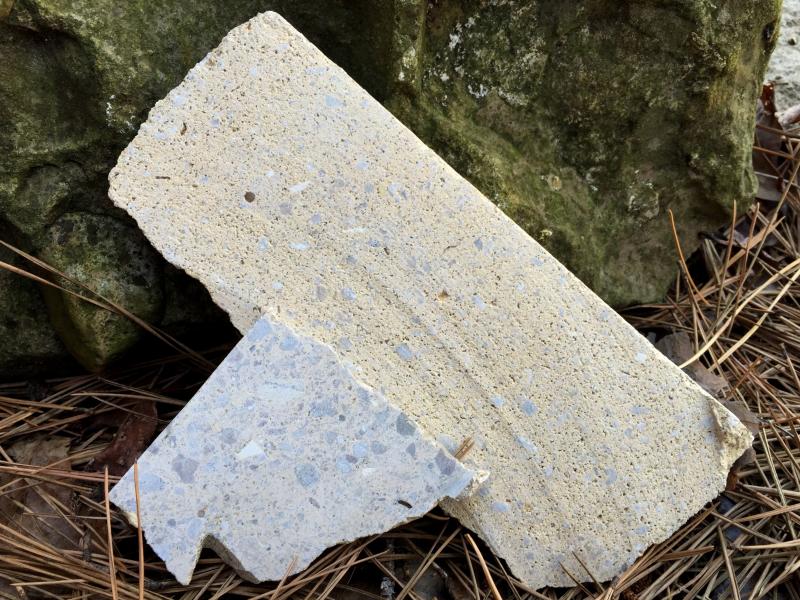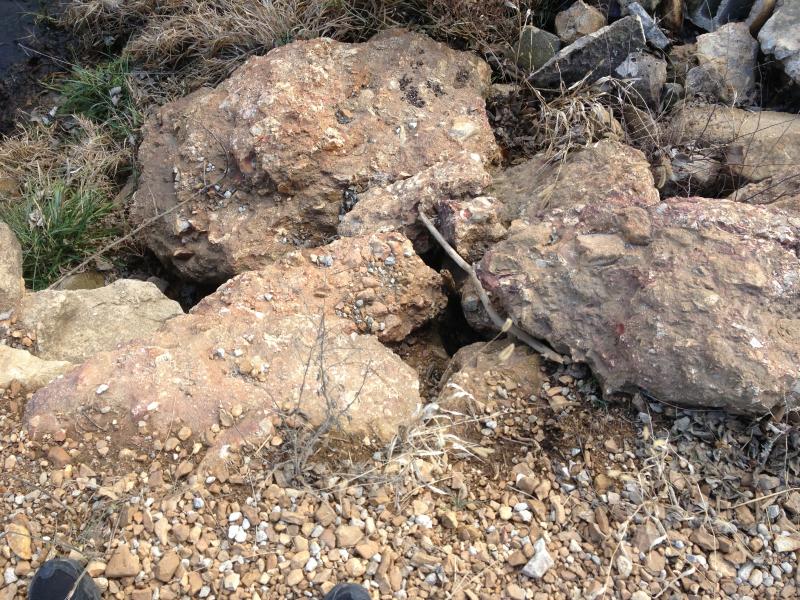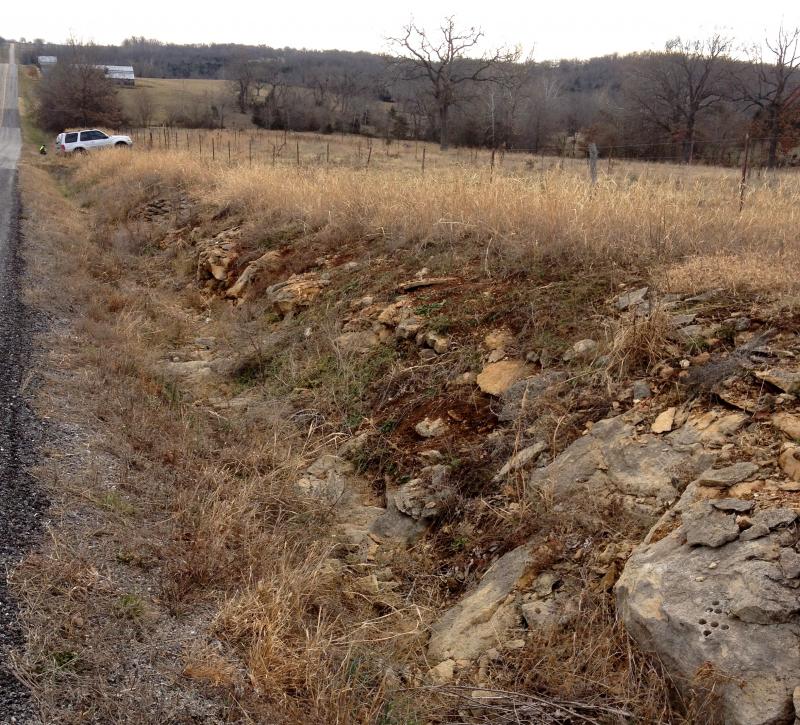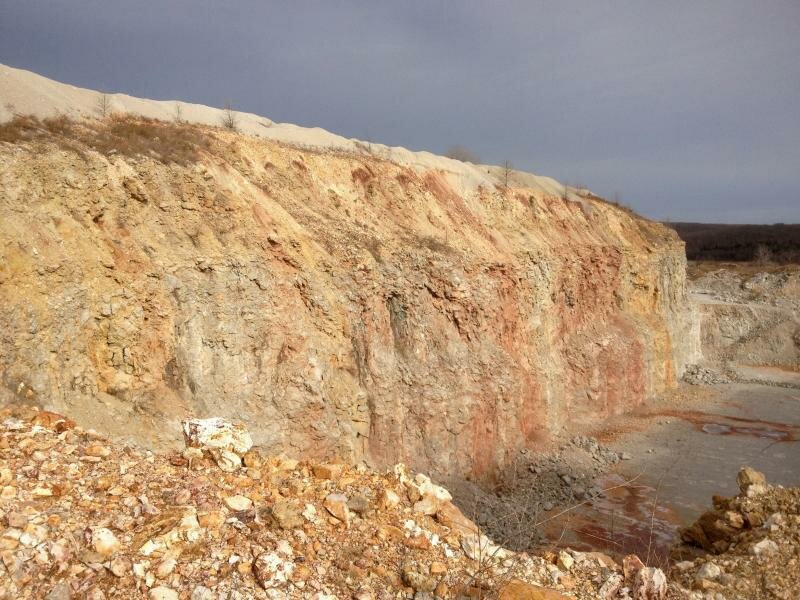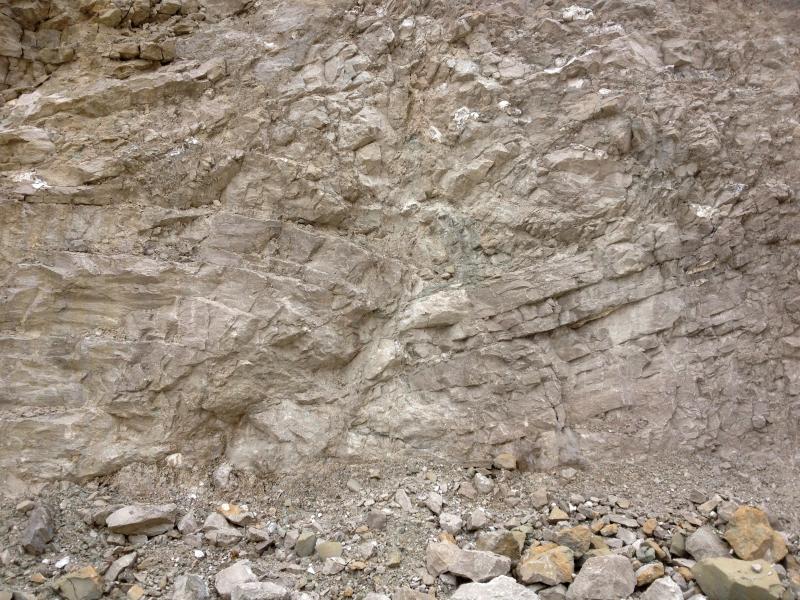United States Meteorite Impact Craters
- Home
- Crater Identification
- Alamo, Nevada
- Ames, Oklahoma
- Avak, Alaska
- Barringer, Arizona
- Beaverhead, Montana
- Chesapeake Bay, Virginia
- Cloud Creek, Wyoming
- Crooked Creek, Missouri
- Decaturville, Missouri
- Decorah, Iowa
- Des Plaines, Illinois
- Flynn Creek, Tennessee
- Glasford, Illinois
- Glover Bluff, Wisconsin
- Haviland, Kansas
- Kentland, Indiana
- Manson, Iowa
- Marquez, Texas
- Middlesboro, Kentucky
- Newporte, North Dakota
- Odessa, Texas
- Red Wing, North Dakota
- Rock Elm, Wisconsin
- Santa Fe, New Mexico
- Serpent Mound, Ohio
- Sierra Madera, Texas
- Upheaval Dome, Utah
- Weaubleau, Missouri
- Wells Creek, Tennessee
- Wetumpka, Alabama
- Possible Impacts
- User-submitted Possibles
- Open Questions
- About This Website
Weaubleau, Missouri

Summary:
The Weaubleau (or Weaubleau-Osceola) structure appears to be a 7 to 8 km diameter impact crater located in St. Clair County, Missouri. It dates from the latest Osagean to earliest Meramecian stage of the Mississippian, about 340 million years ago.
Though unambiguous indicators of a hypervelocity impact are present at the Weaubleau location, the structure is only partially exposed, and the precise perimeter and dimension of the structure are not yet well mapped.
The Weaubleau (or Weaubleau-Osceola) site was first observed, described, and mapped as a localized area of intense structural deformation and brecciation by Thomas Beveridge, in 1951. In 2003, Dr. Kevin Evans observed a circular structure while preparing DEMs of the area. An initially observed 19km roughly circular region appeared to relate to the combined mapped breccia and disturbed region described by Beveridge. Later, a smaller circular basin, located in the SW corner of the larger circular structure was identified in clear DEMs. This smaller, later identified structure corresponds roughly to an area of 'Mississippian conglomerate' described by Beveridge. Beveridge's rock unit has subsequently been informally named the Weaubleau Breccia in many publications. The conglomerate is, by subsequent description, a breccia containing lithoclasts of every rock unit from the uplifted and fragmented igneous basement through latest Osagean to Meramecian Burlington-Keokuk deposits.
The Weaubleau-Osceola structure is situated on the Springfield Plateau, within the Ozark Plateaus geophysical region. The exposed ground surface is typical of dissected portions of the Springfield Plateau, with the ground surface in uplands comprised of Pennsylvanian to Mississippian sediments and the valley bottoms cutting down into the Ordovician sediments of the undifferentiated Cotter-Jefferson City Dolomite formation. A substantial unconformity separates the buried surface of the Salem Plateau from the overlying Mississippian and Pennsylvanian Springfield Plateau layers. Evans, in a 2006 GSA abstract, mentions the overlying Pennsylvanian layers as unconformably covering post impact depositions from the earlier Meramecian series Warsaw and Salem formations. The Meramecian series dates from about 340 to 333 million years ago, during the Mississippian period.
The impact occurred, according to paleomagnetic and conodont work, between the latest Osagean and earliest Meramecian stages of the Mississippian, about 340 million years ago. This is backed by several lines of evidence. Miller et al., 2006 and 2007, in GSA abstracts, presented results of conodont and macro-fossil (crinoids, blastoids, corals, and brachiopods) analysis of breccias from the Weaubleau site. The Weaubleau resurge breccias are found to contain a mix of conodonts (and some later macro-fossils) from the Ordovician, Devonian, and the Kinderhookian and Osagean Mississippian, up to the Osagean-Meramecian boundary. They report that the recovery of Osagean to Meramecian conodonts from within the breccia, combined with the finding of fossils from only slightly more recent history (Meramecian) in the remains of overlying unimpacted Warsaw formation sediments, suggests a strong constraint for the impact at the Osagean-Meramecian boundary. They further report that there is evidence that the Osagean to Meramecian Burlington-Keokuk formation limestone was uncemented sediment at the time of the impact.
Evidence of Impact Origin
The impact origin of each location listed on this website has been supported by unambiguous diagnostic evidence of hypervelocity impact that has been reported in a scientific (usually peer reviewed) context. Without such evidence, a geological structure is not a confirmed impact crater. This section, which is included for each crater on this website, is not an exhaustive list of such published evidence, but is meant to demonstrate that appropriate work has been done for each listing.
Morrow, et al., 2007
Nature of diagnostic evidence: Planar deformation features in quartz. (up to 5 sets, further described and indexed in Morrow and Evans, 2007 and other reports). Other significant evidence: breccia, megabreccia, distinct circular structure revealed in DEMs. Substantial work has been done at this site, though questions remain regarding specific crater boundary.
A Visit to the Crater:
Weaubleau is located, as the Weaubleau-Osceola name implies, approximately between the towns of Weaubleau and Osceola in west-central Missouri, about 50 miles (80 km) NNW of Springfield, MO. It falls in southeast St. Clair County, and is easily accessed, since it is roughly bisected from north to south by Missouri Highway 13, and is cross cut by several smaller roads. The town of Vista, Missouri, is located about 3 miles north of the center of a 7-8 km diameter region representing the best current understanding of the location of the crater itself. This rests within a larger 18 to 19 km region of intensely but variably disturbed rock, possibly representing a preserved section of the rim and proximal ejecta blanket of a proposed oblique impact. Bedrock is largely covered by soil and fine grained, clast-bearing sediment in the region.

In the region surrounding the crater, the sedimentary rocks conform to the regional norm of the Ozark Plateau, table-flat marine deposits stacked, as one historical geologist put it, as neatly as a layer cake.
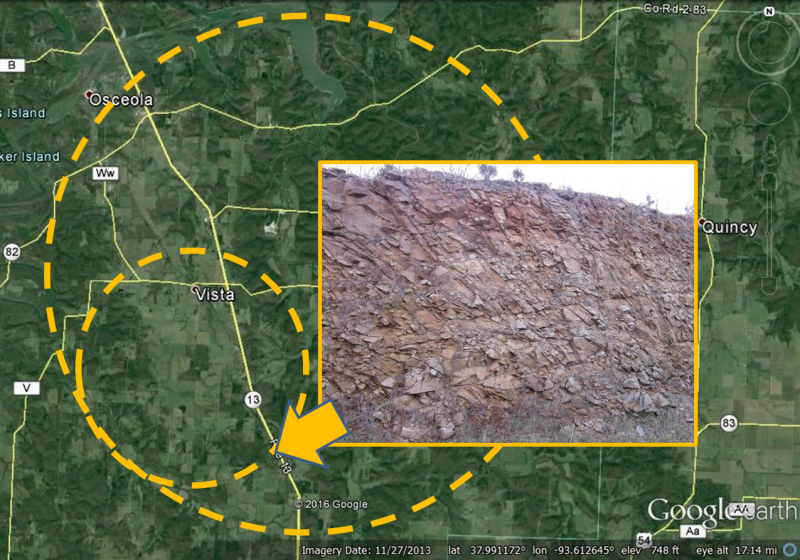
Approaching the crater from the south on MO Route 13, the first sign of something unusual that a visitor encounters is heavily fractured strata, in a road cut, near the southern edge of the crater.
The image above illustrates the intensely fractured strata exposed in the southern road cut, along MO Rte 13. To the north of this, for several miles, the normal regional rock units are replaced by a fine-grained, clast-bearing unit, interpreted by researchers as a resurge breccia.
The Weaubleau resurge breccia, shown in slabs, above, is a fossiliferous carbonate rock unit comprised of fragments of broken limestone, dolostone, chert, sandstone, shale, and fragmented fossils, ranging from less than a millimeter to several centimeters in size, within a muddy carbonate matrix with sparse quartz grains (e.g. Miller et al., 2008) Fragmented crinoid, bryozoan, and brachiopod fossils are abundant. This material dominates most of the surface-exposed rock in and around the structure. Drilling of this material, reported in Miller et al., 2008, as well as in several abstracts, revealed it to be of substantial thickness, and showed increasing abundances of larger clasts and igneous rock fragments as depth increased. Igneous rock fragments were encountered 350 to 400 meters or more above their normal stratigraphic location.
Weaubleau crater is only partially exposed. Within the 7 to 8 km structure, around and south of the community of Vista, much of the bedrock is covered by deep soil or vegetation, but sporadic rock outcrops are present in fields, cut banks, and bar ditches. Such locations almost uniformly reveal the clast-bearing resurge breccia described in literature, and somewhat frustratingly hide the shape of the underlying rocks that would allow the structure to be better mapped.
Where underlying rocks have been excavated or are naturally exposed, along several side roads, they reveal the 'indescribably complex' brecciation, fracturing, and folding described in the earliest accounts of the structure during attempts at regional mapping.
The timing of the abrupt violence that affected the layered sedimentary rocks of this region is remarkably well constrained by fossil and paleomagnetic evidence. The core holes revealed at the lower right of the photograph above, taken just south of Vista, reveal traces of paleomagnetic dating research. Fossils, as shown below, offer abundant additional evidence of both the timing of the impact and the nature of the affected marine environment.
Fossils and paleomagnetic evidence (Miller et al., 2008; Elmore and Dulin, 2007; Dulin and Elmore, 2008) constrain the timing of the impact to the mid-Mississippian, and more specifically, to the latest Osagean or early Meramecian, about 335 to 340 Ma, when the region was covered by a shallow, inland sea.
One of the more unusual features of the Weaubleau Crater outcrops is 'Weaubleau Eggs'. These unusual, nearly-spherical chert concretions are formed where dissolved silica in ground water has been precipitated in layers, growing outward around particular kinds of clasts within the Weaubleau resurge breccia. Because the chert concretions are more resistant to erosion than the surrounding rock, they accumulate in large numbers on weathered surfaces of the breccia. The limestone weathers away, leaving the eggs behind.
When cut open, these nucleated chert nodules reveal a 'yolk' comprised of extremely fine-grained silica. This yolk represent the material around which the concretions grew (Beauford and Evans, 2015; Miller et al., 2008).
Located a mile or so beyond the crater rim, the Ash Grove Aggregates quarry has offered researchers additional insights. Dramatically folded, fractured, and buckled rocks, many meters across, dominate the quarry walls, and are overlain at the top of the sequence by a thick layer of breccia. Please respect private property, and DO NOT attempt to enter the quarry without permission. This is an active business location.
Observers looking at the quarry walls have repeatedly described the cross sections as a 'train wreck', with car to house-sized mega-clasts crushing, twisting, rotating, and rolling over one another, grinding finer material to powder between them, as if they were suddenly and violently accelerated, which is probably a fairly reasonable approximation of what actually happened at this location. The breccia within the crater, a few miles away, is very thick. But here, beyond the apparent crater rim, the strata appear increasingly undisturbed as depth increases.
Bibliography and References:
(If links to articles don't work, don't give up. Try pasting the link shown into a search engine or searching for the article authors, title, or other reference information. If your research leads you to additional scientific references related to this crater, please help improve this resource by sending a note with the new citation(s) to: )
Beauford R. E., Evans K. R. (2015) Origin of concretions in the proposed Weaubleau impact structure, Missouri, USA in Phyical Records of Impacts in The Early and Modern Solar System. Published doctoral dissertation (open access), University of Arkansas. Proquest Dissertations and Theses, Publication #3688247, pp: 48-77.
Beveridge T. A. (1949) The geology of the Weaubleau quadrangle, Missouri. Ph.D. thesis, State University of Iowa, Iowa City, Iowa.
no link found
Beveridge T. R. (1951) The Geology of the Weaubleau Creek Area, Missouri. Missouri Division of Geological Survey and Water Resources, Volume 32, Second Series.
Bretz J. H. (1950) Origin of the filled sink-structures and circle deposits of Missouri. Geological Society of America Bulletin Volume 61, No. 8, pp. 789-834. doi: 10.1130/0016-7606(1950)61[789:OOTFSA]2.0.CO;2
Cox M. R. (2008) Geology of the Vista, Missouri 7.5 minute Quadrangle, St. Clair County, Missouri: unpublished master’s thesis, Missouri State University, Springfield, Missouri. 59 p. and one sheet.
no link found
Cox M. R., Evans K. R. (2007) Geologic map of the Vista 7.5’ Quadrangle, St. Clair county, Missouri: Missouri Department of Natural Resources Division of Geology and Land Survey Open-File Report OFM-07-101-GS.
no link found
Cox M. R., and Evans K. R. (2008) Geologic map of the Vista 7.5’ Quadrangle, St. Clair county, Missouri. Missouri Department of Natural Resources Division of Geology and Land Survey, Open File Report OFR-08-101-GS, 27 p.
no link found
Cox M. R., Evans K. R., Krizanich G. W. (2007) GIS-based geologic mapping of the Vista quadrangle, west-central Missouri (abstract #23-3). Geological Society of America, South-Central and North-Central Joint Section Meeting. Abstracts with Programs, Volume 39, No. 3, p. 25.
Cox M. R., Evans K. R., Plymate T. G., Miller J. (2006) Geologic mapping of the Weaubleau structure, west-central Missouri (abstract #21-5). Geological Society of America. Philadelphia Annual Meeting. Abstracts with Programs 38(7):58.
Davis G. H. (2005) The use of shallow geotechnical drilling to delineate the Weaubleau-Osceola Impact Structure, St. Clair County, Missouri (abstract). SEPM Research Conference: The Sedimentary Record of Meteorite Impacts. Abstracts with Program. p. 12.
Davis G. H., Evans K. R., Miller J. F., Mulvany P. S., Rovey C. W. II. (2005) Weaubleau-Osceola, Decaturville, and Crooked Creek: New Aspects of Missouri’s 38th Parallel Structures (abstract). SEPM Research Conference: The Sedimentary Record of Meteorite Impacts. Abstracts with Program. p. 13.
Dulin S., Elmore R. D. (2005) Paleomagnetism of impacts in shallow-water carbonate sediments: the Weaubleau-Osceola impact and the Alamo Breccia (abstract). SEPM Research Conference: The Sedimentary Record of Meteorite Impacts. Abstracts with Program. p. 13.
Dulin S., Elmore R. D. (2006) Paleomagnetism of the Decaturville impact breccias and the Weaubleau-Osceola structure, southwest Missouri: Testing the serial impact hypothesis (abstract #44-15). Geological Society of America, Annual Meeting. Abstracts with Programs Volume 38, No. 7, p. 121.
Dulin S., Elmore R. D. (2008) Paleomagnetism of the Weaubleau structure, southwestern Missouri. In The sedimentary record of meteorite impacts, edited by Evans K. R., Horton J. W. Jr., King D. T. Jr., and Morrow J. R. Geological Society of America Special Paper 437. pp. 55-64. doi: 10.1130/2008.2437(04)
or
Dulin S. A., Elmore R. D., Gardner K. G. (2005) Impacts in carbonate target rocks: A paleomagnetic study of the Weaubleau-Osceola and Alamo Breccia impact structures (abstract #1371). Abstracts of the 36th Lunar and Planetary Science Conference.
Dulin S. A., Elmore R. D., Mulvany P. S., O'Brien V. (2005) Paleomagnetic constraints on the timing of the Decaturville impact structure, Southwest Missouri (abstract #GP33A-0105). Eos Transactions American Geophysical Union. Fall Meeting Supplement, volume 86, no.52.
Dulin S. A., Gardner K. G., Elmore R. D., Totten L. A. (2004) Post-deformational Remagnetization of the Weaubleau-Osceola Structure, SW Missouri (abstract #56-5). Geological Society of America. 2004 Annual Meeting. Abstracts with Programs, Volume 36, No. 5, p. 145.
Dulin S. A., Gardner K. G., Elmore R. D., Totten L. A., Evans K. R., Miller J. F., Rovey C. W. II (2004) Paleomagnetism of the Weaubleau-Osceola impact structure, SW Missouri (abstract #GP31A-07), Eos Transactions of the American Geophysical Union. Joint Assembly Supplement Volume 85, No. 17.
no link found
Elmore R. D., Dulin S. (2007) New paleomagnetic age constraints on the Decaturville impact structure and Weaubleau structure along the 38th parallel in Missouri (North America). Geophysical Research Letters, volume 34, Issue 13. L13308, doi:10.1029/2007GL030113.
Evans K. (2004) Weaubleau-Osceola Structure: Carbonate Duck Soup, Impact Field Studies Group, Impacts in the Field, Volume 1, Fall, pp. 1-4.
Evans K. R. (2007) A Tattered Tapestry: Interpreting Remote Sensing Imagery of the Ozark Mountains (abstract #31-7). Geological Society of America Joint South-Central and North-Central 41st Annual Meeting. Abstracts with Programs, Volume 39, No. 3, p. 64.
Evans K. R., Cox M. R., Davis G. H., Miller J. F., Rovey C. W. II (2006) Emplacement of breccias in the Weaubleau structure, Missouri, USA: Implications for environmental disturbance in a shallow-marine carbonate setting (abstract), Impact Craters as Indicators for Planetary Environmental Evolution and Astrobiology Workshop, June 8-14, 2006, Östersund, Sweden.
no link found.
Evans K. R., Davis G. H., Miao X., Mickus K. L., Miller J. F., Morrow J. R. (2008) Re-evaluating the 38th parallel serial impact hypothesis (abstract #P31A-1384). Eos Transactions American Geophysical Union. Fall Meeting Supplement Volume 89, Issue 53.
Evans K. R., Davis G. H., Mickus K. L., Miller J. F., Rovey C. W. II. (2005) The Weaubleau-Osceola Structure and Weaubleau Breccia – Compiling Evidence of a Marine Impact (abstract). SEPM Research Conference: The Sedimentary Record of Meteorite Impacts. Abstracts with Program. p. 16.
Evans K. R., Jackson J. S., Mickus K. L., Miller J. F., Cruz D. (2011) Enigmas and Anomalies of the Lower Mississippian Subsystem in Southwestern Missouri (abstract and slides), Tulsa Geological Society presentation, American Association of Petrolium Geologists (AAPG) Datapages, Search and Discovery Article #50406.
Evans K. R., Mickus K. L. (2008) Geophysical, structural, and kinematic analysis of the Weaubleau structure: Implications for an oblique impact (abstract #252-4). Joint Meeting of the Geological Society of America, Soil Science Society of America, American Society of Agronomy, Crop Science Society of America, and Gulf Coast Association of Geological Societies with the Gulf Coast Section of SEPM. Abstracts with Programs, Volume 40, No. 6, p. 379.
Evans K. R., Mickus K. L., Fagerlin S., Luczaj J., Mantei E., Miller J. F., Moeglin T., Pavlowsky R. T., Thomson K. C. (2003) New dimensions of the Weaubleau Structure: A possible meteorite impact site in southwestern Missouri (abstract #17-9). Geological Society of America, North-Central Section Annual Meeting. Abstracts with Program.
Evans K., Mickus K. L., Miller J. F., Davis G. H. (2012) Proximal to Distal Deformation in the Weaubleau Impact Structure, Missouri (abstract #270-13). Geological Society of America Annual Meeting. Abstracts with Programs, Volume 44, No. 7, p. 630.
Evans K. R., Mickus K. L., Rovey C. W. II, Davis G. H. (2003) The Weaubleau-Osceola Structure: Evidence of a Mississippian Meteorite Impact in Southwestern Missouri, in Association of Missouri Geologists Field Trip Guidebook. 50th Annual Meeting. Report of Investigation No. 75. Guidebook No. 26, pp. 1-30.
or
or
Evans K. R., Miller J. F. (2010) Geology of the Decaturville and Weaubleau impact structures, west-central Missouri. 43rd Annual Meeting of the Pander Society, Field Trip Guidebook, 43 pp.
no link found
Evans K., Miller J. F., Ethington R. (2011) Xenoclast Biostratigraphy: Evidence for Mid-Mississippian and Late Ordovician Impacts at Weaubleau and Decaturville Structures, Missouri (abstract #117-11). Geological Society of America Annual Meeting. Abstracts with Programs, Volume 43, No. 5, p. 306.
Evans K. R, Miller J. F., Miao X. (2010) Origins of the 38th parallel structures (abstract #35-1). Geological Society of America North-Central Section and South-Central Section 44th Annual Joint Meeting. Abstracts with Programs Volume 42, no. 2, p. 91.
Evans K. R., Miller J. F., Mulvany P. S., Davis G. H. (2006) Formation and emplacement of impact breccias in carbonate target rocks: Examples from southern Missouri (abstract #21-4). Geological Society of America Annual Meeting. Abstracts with Programs, Volume 38, No. 7, p. 58.
Evans K. R., Mulvany P. S., Miller J. F., Mickus K.L., Davis G. H. (2005.) Field Trip 1: Weaubleau Osceola, in SEPM Research Conference: The Sedimentary Record of Meteorite Impacts, Field Trips Guidebook.
no link found
Evans K. R., Rovey C. W. II, Davis G. H., Mantei E. J., Mickus K. L., Miller J. F., Moeglin T. D., Plymate T. G. (2004) Oblique impact at Weaubleau-Osceola Structure, Missouri (abstract #110-12). Geological Society of America Annual Meeting. Abstracts with Program Volume 36, No. 5, p. 266.
Evans K. R., Rovey C. W. II, Mickus K. L., Miller J. F., Plymate T. G., Thomson K. C. (2003) Weaubleau-Osceola structure, Missouri: deformation, event stratification, and shock metamorphism of a mid-Carboniferous impact site (abstract #4111). Third International Conference on Large Meteorite Impacts, Nordlingen, Germany.
Finn M. P., Krizanich G. W., Evans K. R., Cox M. R., Yamamoto K. H. (2012) Visualizing Impact Structures Using High-Resolution LiDAR-Derived DEMs: A Case Study of Two Structures in Missouri. Surveying and Land Information Science, Volume 72, No. 2, pp. 87-97.
Finn M. P., Krizanich G. W., Evans K. R., Usery E. L. (2007) Contemporary high-resolution LiDAR derived digital elevation models could inspire developments in the study of impact structures (poster). Proceedings of the Association of American Geographers, Great Plains / Rocky Mountain Section Annual Meeting.
Finn M. P., Krizanich G. W., Usery E. L. (2007) Contemporary High-Resolution LiDAR Derived DEMs Could Inspire Developments in the Study of Impact Structures (abstract wi. poster GS004 - 2871). Proceedings of the International Union of Geodesy and Geophysics 24th General Assembly, Perugia, Italy.
Lemons C. R. (2008) Microstructural Analysis of Calcite Within the Weaubleau Structure, West-Central Missouri (abstract #5-7). Geological Society of America South-Central Section, 42nd Annual Meeting. Abstracts with Programs, Volume 40, No. 3, p. 8.
McCracken M. H. (1966) Major Structural Features of Missouri (map). Missouri Department of Natural Resources Division of Geology and Land Survey, DNR/DGLS Fact Sheet No. 6.
Miao X., Evans K. R, Morrow J. R. (2007) Serial impacts or random alignment? Monte Carlo simulations of three 38th parallel impact structures (abstract #5312). Abstracts of the 70th Annual Meteoritical Society Meeting, Meteoritics and Planetary Science, Volume 42, Issue S8 (supplement), p. A106. DOI: 10.1111/j.1945-5100.2007.tb00601.x
or
Mickus K. L., Evans K. R., Rovey C. W. II. (2005) Gravity and Magnetic Analysis of the Weaubleau-Osceola Structure, Missouri (abstract). SEPM Research Conference: The Sedimentary Record of Meteorite Impacts. Abstracts with Program. p. 25-26.
Middendorf, M.A., Thomson, K.C., Easson, G.L., and Sumner, H.S., 1991, Bedrock geology of the Springfield 1 x 2 quadrangle, Missouri: United States Geological Survey Miscellaneous Investigations Map, MI-2029.
see also: Missouri Geological Survey bedrock geology 7.5' quadrangle maps of the Vista area, including Beveridge, T. R. (1949) and Middendorf, M. A. (1984) can be found at
Miller J. F., Bolyard S., Evans K. R., Ausich W. I., Ethington R. L., Thompson T. L., Waters J. A. (2005) Implications of fossils in the ejecta breccia associated with the Weaubleau-Osceola Structure, St. Clair County, Missouri (abstract). SEPM Research Conference: The Sedimentary Record of Meteorite Impacts. Abstracts with Program. p. 26.
Miller J. F., Evans K. R. (2007) The Weaubleau and Decaturville impact structures in west-central Missouri: sorting out their ages using re-deposited conodonts and crinoids in breccias. Pander Society Field Trip Guidebook, 37 p.
no link found
Miller J. F., Evans K. R., Ausich W. I., Bolyard S. E., Davis G. H., Ethington R. L., Rovey C. W. II., Sandberg C. A., Thompson T. L., Waters J. A. (2008) Mixed-age echinoderms, conodonts, and other fossils used to date a meteorite impact, and implications for missing strata in the type Osagean (Mississippian) in Missouri, USA. In Echinoderm Paleobiology, edited by Ausich W. I. and Webster G. D., University of Indiana Press, Bloomington. p. 246-288.
Miller J. F., Evans K. R., Bolyard S. E., Thompson T. L., Davis G. H., Ausich W. I., Waters J. A., Ethington R. L. (2005) Mixed-age echinoderms, conodonts, and other fossils from a mid-Mississippian impact resurge breccia, St. Clair County, Missouri (abstract #25-7). Geological Society of America Annual Meeting, Abstracts with Programs, Volume 37, No. 7, p. 62.
Miller J. F., Evans K. R., Ethington R. L., Repetski J. E., Sandberg C. A., Thompson T. L. (2007) Critical stratigraphic data from reworked conodonts in impact breccias across Missouri’s Ozark Dome (abstract #30-5). Geological Society of America Annual Meeting. Abstracts with Programs, Volume 39, No. 3, p. 62.
Miller J. F., Evans K. R., Kurtz V. R., Thompson T. L., Mulvaney P. S., Sandberg C. A., Repetski J. E., Ethington R. L. (2006) Using conodonts and other fossils to determine the age of Missouri's 38th Parallel Structures and some "Lost Horizons" of the Ozark Dome (abstract #69-11). Geological Society of America Annual Meeting. Abstracts with Programs, Volume 38, No. 7, p. 184.
Miller J. F., Thompson T. L., Ethington R. L. (2010) Conodonts and other fossils from cores in the resurge breccia at the Weaubleau impact structure, St. Clair County, Missouri (abstract #9-12). Geological Society of America North-Central Section and South-Central Section Joint Annual Meeting. Abstracts with Programs, Volume 42, No. 2, p. 50.
Moon K. E., Evans K. R., Miller J. F., Davis G. H. (2010) Weaubleau impact virtual core library (abstract #116-6). Geological Society of America Annual Meeting. Abstracts with Programs, Volume 42, No. 5, p. 305.
Morrow J. R., Evans K. R. (2007) Preliminary shocked-quartz petrography, upper Weaubleau breccia, Missouri, USA (abstract #5237). Abstracts of the 70th Annual Meteoritical Society Meeting, Meteoritics and Planetary Science, Volume 42 (supplement).
Rampino M. R., Volk T. (1996) Multiple impact event in the Paleozoic: Collision with a string of comets or asteroids? Geophysical Research Letters, Volume 23, Issue 1, pp. 49-52. doi:10.1029/95GL03605
Rovey C. W. II, Evans K. R., Mickus K. L., Miller J. F., Plymate T. G., Thomson K. C. (2003) Impact origin of the Weaubleau-Osceola Structure in southwestern Missouri (abstract #156-6). Geological Society of America Annual Meeting. Abstracts with Programs, volume 35, No. 6, p. 339.
Shoberg T., Stoddard P. R. (2007) Gravity and Magnetic Surveys of the Weaubleau Quadrangle, South Central Missouri: Implications for an Impact Origin of the Weaubleau-Osceola Structure (abstract #U23A-0860). Eos Transactions American Geophysical Union. Fall Meeting Supplement, Volume 88, 52.
Snyder F. G., Gerdemann P. E. (1965) Explosive igneous activity along an Illinois-Missouri-Kansas axis. American Journal of Science, Volume 263, No. 6, pp. 465-493. doi: 10.2475/ajs.263.6.465
Steadman J. A. (2007) A petrographic study of the Weaubleau-Osceola and Crooked Creek impact structures, Missouri (abstract #1-1). Geological Society of America, South-Central and North-Central Joint 41st Annual Section Meeting. Abstracts with Programs, Volume 39, No. 3, pp. 1.
Stockdell R. B., Mickus K., Davis G. H., Evans K., Miller J. F., Rovey C. (2004) Bouguer gravity and magnetic anomalies associated with the Weaubleau-Osceola impact structure, Missouri (abstract #11-3). Geological Society of America North-Central Section 38th Annual Meeting. Abstracts with Programs, Volume 36, No. 3, p. 18.
Copyright 2011, 2012, 2013, 2014, 2015, 2016 United States Meteorite Impact Craters. All rights reserved.

